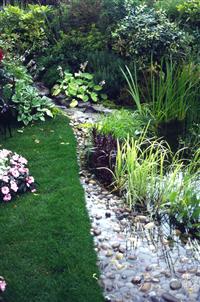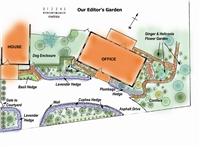COURSE CONTENT
 There are 30 lessons are outlined as follows:
There are 30 lessons are outlined as follows:
- Introduction to Landscaping
- Plant Identification
- History of Gardening
- Drawing Plans
- Soils & Nutrition
- Understanding the Environment
- Earthworks & Surveying
- Basic Landscape Construction
- Surfacings
- Garden Structures
- Park Design
- Home Garden Design
- Costing & Specifications
- Trail Design
- Tools & Machinery
- Plant Establishment Techniques
- Ponds & Pools
- Rockwork & Masonry
- Lawn Construction Techniques
- Irrigation Design & Installation
- Bush Garden Design
- Cottage Garden Design
- Playground Design
- Garden Bed Design
- Management
- Land Rehabilitation
- Drainage
- Maintenance
- Dealing with Clients
- Major Design Project
EXAMPLES OF TASKS UNDERTAKEN IN THIS COURSE
The following are only some of the activities that the student will undertake in this course.
 Find a site to be landscaped. (It could be a park or home garden; it could be a new development or a redevelopment of an older garden). Visit the site and record pre planning information required to design the landscape.
Find a site to be landscaped. (It could be a park or home garden; it could be a new development or a redevelopment of an older garden). Visit the site and record pre planning information required to design the landscape.- Find five examples of the use of landscape principles. Using sketches and written descriptions, describe the way the garden has been laid out in order to achieve those particular effects.
- Find gardens which represent three different styles. Submit a photograph or sketch plan of each along with a half page written description of the style of the garden. Explain any historical influences, including the influence of those who build to owned the garden. The gardens may be gardens you have actually visited, or can be gardens you have seen in a magazine or book.
- Copy the drawings of symbols (ie. drawings which show you how to represent plants, walls, rocks, etc. when you draw plans). Practice drawing these various components of a landscape.
- Using the pre-planning information collected, produce a design for that area. or part of that area.
- Take a sample of soil and attempt to name it using the test given.
- Obtain components of potting or soil mixes; make up different mixes and test their characteristics.
- Survey an area requiring earthmoving. Draw a plan of the area, to scale, showing the area to be excavated.
- Calculate the volume of earth to be removed. Calculate where it is to be put.
- Find, observe & report on some bad landscape construction work. (You might discuss a poor rockery, a wall which is falling over, or some playground equipment which is unsafe.)
- Find three examples of bad selection of surfaces in a landscape (ie. home garden, park, sports oval, tennis court or whatever). Describe the material used and explain why they are bad. Consider both the aesthetic and functional qualities of the surfacing.
- Develop a redevelopment plan for an existing park. Submit a photograph of the park as it exists at the moment (otherwise submit a rough sketch). Prepare a design for redevelopment in line with the suggested changes.
- Choose an established home garden (your own or a friends), and draw a sketch plan as the garden exists. Explain how well do you think this garden is designed?
- Find another home garden, needing either a new design or redevelopment. Prepare four rough sketches showing the stages you would go through in designing or redesigning that particular garden.
- Develop a detailed explanation of how you prepared your costing in the set task. Show the various components of the costing and explain how and why you costed it this way rather than higher or lower.
- Design a trail. It can be any type of trail (fun & fitness, nature, history, etc.) and may be located anywhere (a street, park, home garden, etc).
- Find and visit some recently landscaped gardens (completed within the last 4 months). Visit up to three different properties. Take note of any problems with the maintenance. Consider what could have been done to prevent these problems occurring.
- Design a perennial border along the front wall of a brick house
- Prepare a plan for the establishment of a large number of trees in a degraded area. This plan should cover at least 5 years. You should indicate clearly what the problem is and how you are going to use the trees to help rehabilitate the area.
- Design a water feature (eg. a pond or creek bed) for a bush or natural garden. Submit plans and a step by step description showing how you would construct such a water feature.
- Design a rockery area for a bush garden.
- Design a bush garden using mainly ferns, for a small courtyard of specified dimensions.





